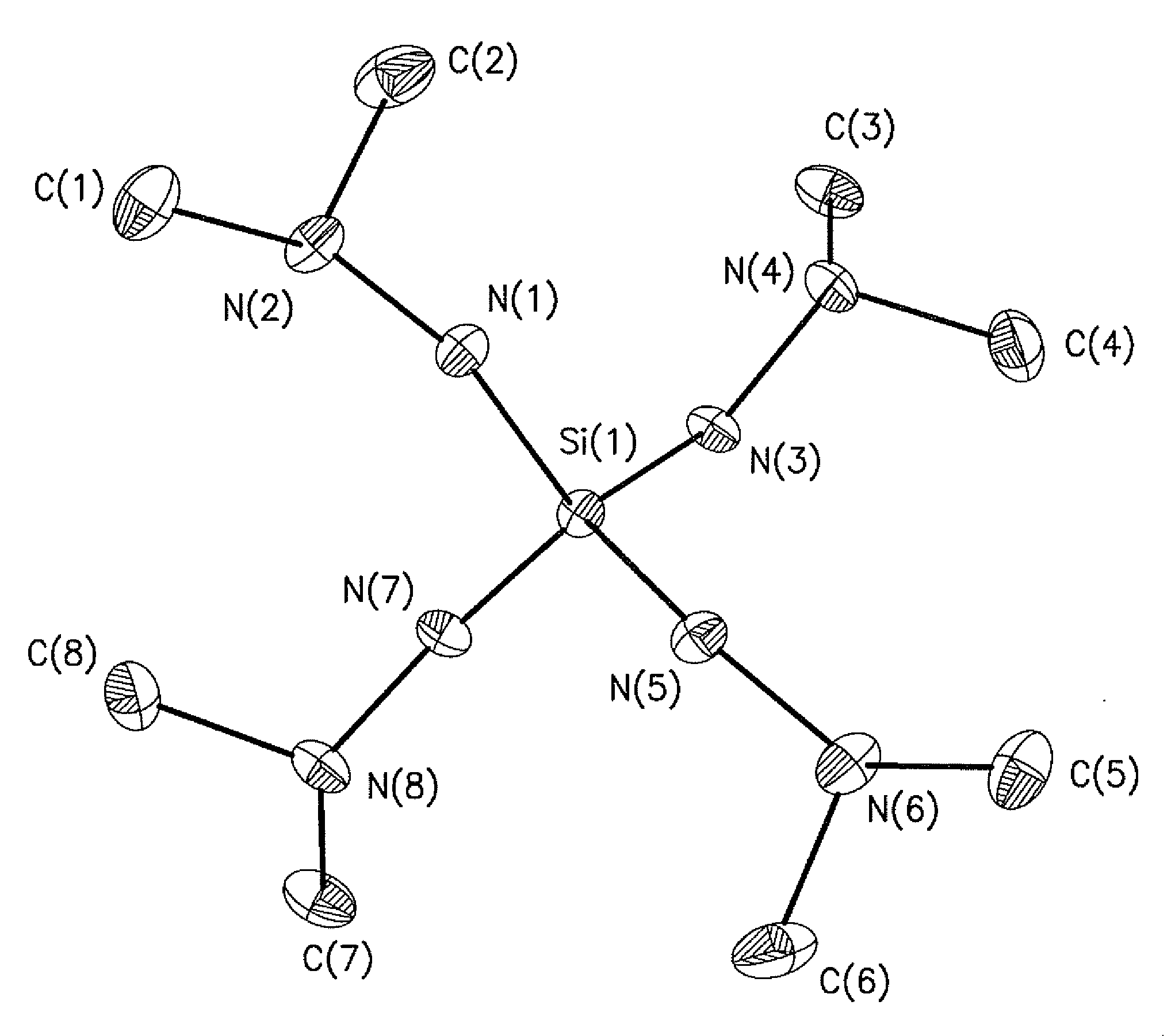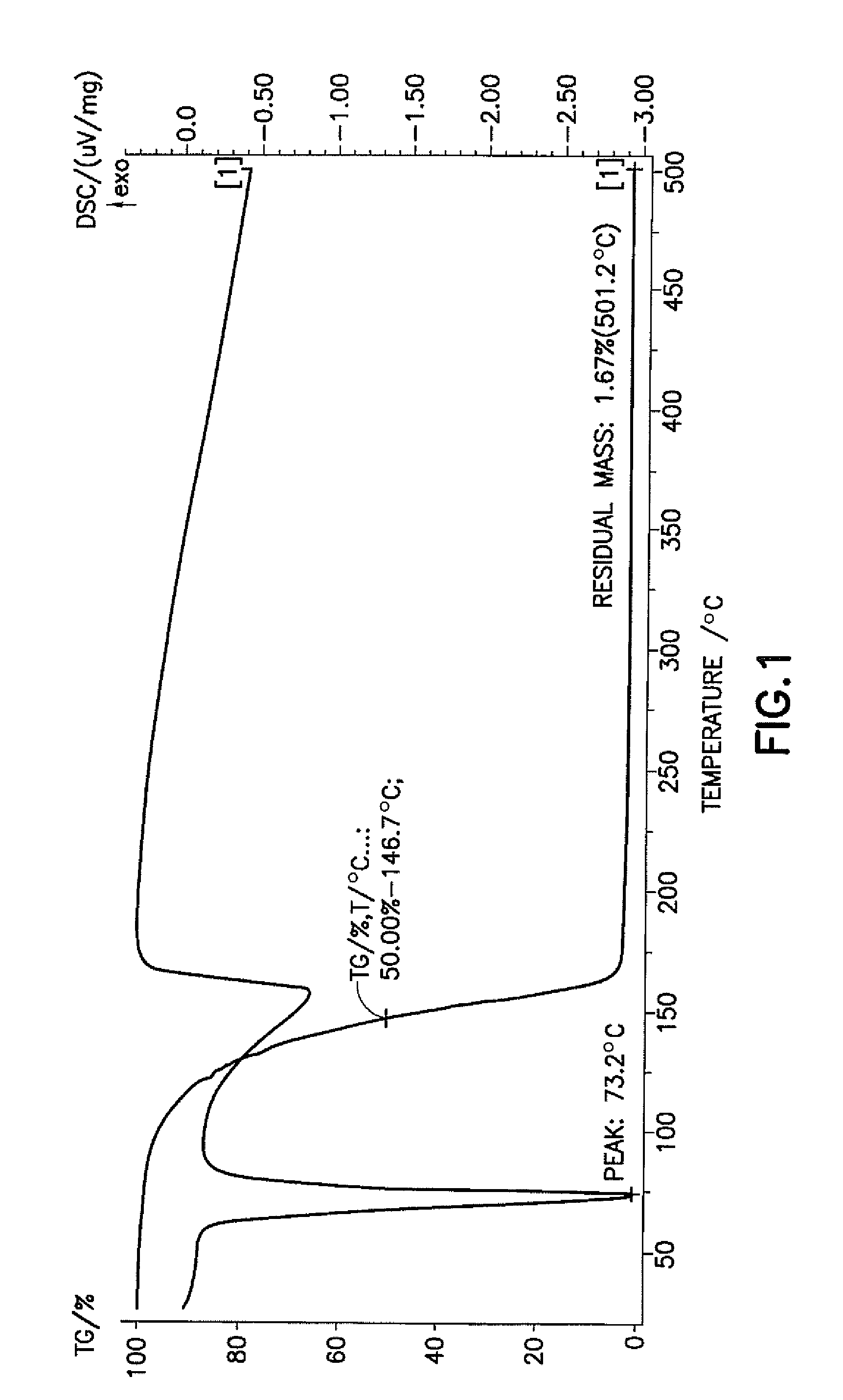Monosilane or disilane derivatives and method for low temperature deposition of silicon-containing films using the same
a technology of monosilane or disilane, applied in the field of silicon-containing film formation, can solve the problems of reducing the life time and long-term performance of the device, particle contamination and solid build-up, and the manufacturing of the devi
- Summary
- Abstract
- Description
- Claims
- Application Information
AI Technical Summary
Problems solved by technology
Method used
Image
Examples
example 1
Synthesis and Characterization of Me3Si(HNNMe2)
[0031]A 3 L flask was filled with a solution comprising 2.5 L hexanes, 54.0 grams (0.53 mol) NEt3, and 30 grams (0.50 mol) of H2NNMe2. 58 grams (0.53 mol) Me3SiCl, as dissolved in 500 mL of hexanes, was slowly added into the 3 L flask at 0° C. White precipitate was observed during the addition of Me3SiCl. After the completion of the reaction, the mixture was warmed to room temperature, stirred overnight, and then filtered. The crude yield was in 80%. Regular distillation procedure was used to purify the end product, which has a boiling point of approximately 100° C. 1H NMR(C6D6): δ 0.15 (s, 9H, —SiCH3), 1.73 (br, 1H, —NH), 2.22 (s, 6H, —NCH3). 13C{1H} NMR(C6D6): δ−0.54 (—SiCH3), 52.4 (—NCH3). Mass spectrum: m / z 132 [M+], 117 [M+−Me)], 102 [M+−2Me)], 88 [M+−3Me)], 73 [M+−(—HNNMe2)].
[0032]Me3Si(HNNMe2) is a liquid at room temperature.
example 2
Synthesis and Characterization of Si(HNNMe2)4
[0033]A 250 mL flask was filled with a solution comprising 200 mL hexanes, 12.2 grams (120.7 mmol) NEt3, and 7.25 grams (120.7 mmol) HNNMe2. 5.0 grams (29.4 mmol) SiCl4, as dissolved in 15 mL of hexanes, was slowly added into the 250 mL flask at 0° C. White precipitate was observed during the addition of SiCl4. After the completion of the reaction, the mixture was stirred overnight and then filtered at room temperature. All volatile materials were removed from the filtrate under vacuum. The crude yield was in 65% (5.0 g, 19.0 mmol). Purified end product was obtained by recrystallization in hexanes at −5° C. 1H NMR(C6D6): δ 2.42 (s, 24H, —CH3), 2.47 (br, 4H, —HN). 13C{1H} NMR(C6D6): δ 52.7 (—CH3). C8H28N8Si: Found (calculated) C, 36.15% (36.34%), H, 11.02% (10.67%), N, 42.66% (42.37%).
[0034]Si(HNNMe2)4 is a solid material having a melting temperature of approximately 73° C. The thermal stability of Si(HNNMe2)4 in solution at 100° C. was m...
example 3
Synthesis and Characterization of Me2(HNNMe2)Si—Si(HNNMe2)M2
[0037]A 3 L flask was filled with a solution comprising 2.5 L hexanes, 57 grams (561 mmol) anhydrous NEt3, and 50 grams (267 mmol) of Me2(Cl)Si—Si(Cl)Me2. 34 grams (561 mmol) H2NNMe2, as dissolved in 100 mL of diethyl ether, was slowly added into the 3 L flask at room temperature. White precipitate was observed during the addition of H2NNMe2. After the completion of the addition of H2NNMe2, the mixture was stirred overnight, and then filtered. All volatile materials were removed from the filtrate under vacuum. The crude yield was in 86% (54 g, 230 mmol). Vacuum distillation procedure was used to purify the end product, which has a boiling point of approximately 45° C. at 35 mTorr. 1H NMR(C6D6): δ 0.33 (s, 12H, —CH3Si), 1.90 (br, 2H, —HN), 2.27 (s, 12H, —CH3N). 13C{1H} NMR(C6D6): δ−0.68 (—SiCH3), 52.6 (—NCH3). Mass spectrum: m / z 175 [M+−(—HNNMe2)], 132 [M+−(—HNNMe2)−(—NMe2)], 116 [M+−(—SiMe2(HNNMe2)]. C8H26N4Si2: Found (cal...
PUM
| Property | Measurement | Unit |
|---|---|---|
| temperature | aaaaa | aaaaa |
| temperature | aaaaa | aaaaa |
| temperature | aaaaa | aaaaa |
Abstract
Description
Claims
Application Information
 Login to View More
Login to View More - R&D Engineer
- R&D Manager
- IP Professional
- Industry Leading Data Capabilities
- Powerful AI technology
- Patent DNA Extraction
Browse by: Latest US Patents, China's latest patents, Technical Efficacy Thesaurus, Application Domain, Technology Topic, Popular Technical Reports.
© 2024 PatSnap. All rights reserved.Legal|Privacy policy|Modern Slavery Act Transparency Statement|Sitemap|About US| Contact US: help@patsnap.com










